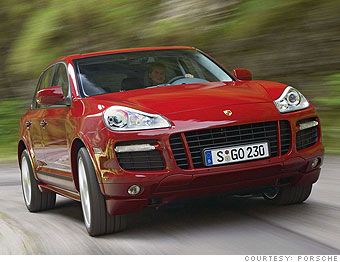It's not the price, it's the Dollar
NEW YORK (CNNMoney.com) -- The weakened dollar isn't just wreaking havoc for Americans traveling overseas - it is hitting consumers right at home.
From soaring prices at the pump to rising food costs, the impact of the declining greenback has been far reaching.
"It touches on so many things when you think about it," said Dustin Reid, senior currency analyst at ABN AMRO in Chicago.
On Monday, the dollar managed a modest rebound against the euro, as the 15-nation currency bought $1.5756, down from $1.5775 late Thursday, but still remains far below where it was just a year ago. The greenback also gained against the British pound in morning trade, but slipped against the Japanese yen.
Oil and gas Many analysts have blamed soaring oil prices, at least in part, on the declining dollar.
Oil, like many other commodities such as wheat and gold, is priced in dollars. So if the greenback weakens, many investors buy the commodity at its current price to hedge against inflation. The drop in the value of the dollar also forces producers and traders to demand more in dollars for their oil in order to reflect its current value.
That increase, however, is not just reflected at the pump. Companies facing rising fuel and ultimately transportation costs often times are forced to pass those increases onto consumers.
Just last week, Dow Chemical Co (DOW, Fortune 500). announced plans to raise the price of its goods by as much as 25% as a result of rising energy costs.
Imports But consumers' pain doesn't end there. They are also getting squeezed by paying more for imported goods.
Even if you don't indulge in Russian caviar or wear a tailored European suit, many everyday items - such as clothing and electronics - as well as the raw materials used to produce American products, come from overseas.
When the dollar's value deteriorates, Americans find that their purchasing power doesn't go as far for foreign goods. But if demand for imports remains strong, that could widen the trade deficit and put further pressure on the dollar.
Exports One silver lining amid all the dollar doom recently has been the boom in U.S. exports.
While the nation's trade gap widened in April, exports have been on the rise in recent months as a weaker dollar makes domestically produced goods more attractive to foreign buyers.
That has also helped lift sales for U.S. manufacturers that export their goods. Shoemaker Nike Inc. (NKE, Fortune 500), which posted a 12% jump in quarterly profit last week, was helped in large part by international sales.
"The fact that the dollar is weak is keeping this country out of a recession and keeping some jobs on the board," said ABN AMRO's Reid.
How we got here To be certain, the dollar has been falling against some of the world's biggest currencies for the better part of this decade.
Much of that decline was driven by the country's widening budget and trade deficits, as the country imported more goods than it exported and the United States government revved up its spending to handle the costs of the war in Iraq.
But it wasn't until the credit crunch erupted that the greenback's decline picked up speed. As of the end of May, the U.S. Dollar Index, which measures the greenback's performance against six of its biggest trading partners, has fallen just over 11%.
Hoping to keep the economy from tipping into a recession, the Federal Reserve swung into action, cutting short-term interest rates seven times since September.
That only served to pressure the dollar further as lower interest rates make dollar-denominated investments less attractive to outside investors. Strong levels of investment in U.S. bonds and equities by overseas governments and foreign investors have long helped prop up the dollar.
Still, most market observers are betting the Fed won't hike rates until later this year or in 2009. There are also no signs of the government cutting back on spending. So the dollar is likely to remain under pressure in the near term.
But that could change once the currency markets get a better sense of the budget plans of the two presidential candidates, notes Shaun Osborne, chief currency strategist in Toronto at TD Securities Inc.
"We have seen already that the dollar is an issue for both McCain and Obama," said Osborne. "But a lot depends on what the new administration does."
Hope for a rescue? Some currency experts such as Kevin Chau, a foreign exchange analyst at IDEAGlobal in New York, are betting that the dollar won't stage a recovery. They see higher oil and food prices continuing to weigh on U.S. consumer confidence, while the outlook for the nation's economy grows increasingly bleaker.
An increasing perception that the dollar is oversold by traders or an interest rate hike by the Federal Reserve would help prop up the greenback, but most market observers aren't expecting that to happen until at least the fall - and possibly not until next year.
Were the dollar's condition to severely worsen, both the Treasury Department and the Federal Reserve could orchestrate a rescue by tightening the money supply, including repurchasing government bonds. Or they could seek help from other central banks, who would buy dollar-based assets.
In the meantime, currency experts anticipate that top officials - including Treasury Secretary Henry Paulson and Fed Chairman Ben Bernanke - will rely on the dollar remedy of choice: publicly stating they support a strong dollar policy. ![]()




























